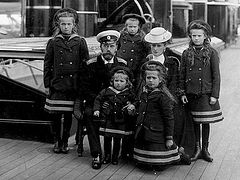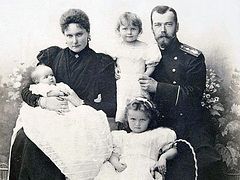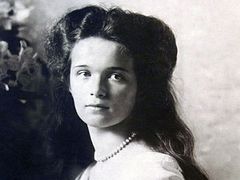This past summer, July 17, 2018, marked the centenary of the killing of the Romanov family—Tsar Nicholas, his wife, Tsarina Alexandra Feodorovna, their daughters Olga, Tatiana, Maria, Anastasia, and son Alexei.
What were the royal children like? What did they dream of and what did they manage to achieve in their short, but so wonderful lives?
What was the royal family like? Its icons epitomize the unity of the angels, depicted by Andrei Rublev on his renowned icon of the Holy Trinity. There are photos where the four sisters seem so alike, that it’s rather challenging to not to confuse them.
In fact, the royal children were all completely different. Although they always tried to stick together, each life was a unique story, ending tragically.
Grand Duchess Olga: “I’m Russian, and I wish to stay in Russia”
 Grand Duchess Olga, Tsar Nicholas’s eldest daughter, was known as a “well-read”, “wonderfully intelligent”, “pure soul”, “having a good ear for music”, “fond of books and solitude”. She was born in November 1895, a year after her parents were married. At just eleven days old, Olga received Holy Communion after the Sacrament of Baptism in a church of the Catherine Palace.
Grand Duchess Olga, Tsar Nicholas’s eldest daughter, was known as a “well-read”, “wonderfully intelligent”, “pure soul”, “having a good ear for music”, “fond of books and solitude”. She was born in November 1895, a year after her parents were married. At just eleven days old, Olga received Holy Communion after the Sacrament of Baptism in a church of the Catherine Palace.
Olga Nikolaevna was very emotional in character and prone to be a leader at the same time. She would often let Tatiana take the leading role, despite being sixteen months younger. They tended to wear similar clothes, shared the same bedroom, and confided their intimate secrets to each other.
Olga was known to be her father’s daughter. If there was a question she couldn’t answer, she would say, “Ask my father”. Around her neck was a locket with a portrait of Nicholas II. This image would later be found in Ekaterinburg, in Ganina Yama.
Sometimes she squabbled with her mother. When Alexandra Fedorovna found an eligible man for her, the Romanian prince Carol, Olga caustically dubbed him Carlusha. When the parents talked about her marriage, she would insist, “I’m Russian, and I wish to stay in Russia”. She was once infatuated with Grand Duke Dmitry Pavlovich. A brave officer and athlete, he did not hide his aversion to Gregory Rasputin. The Tsarina would under no circumstances agree to accept her daughter’s choice, and Olga humbly obeyed her mother’s will.
In her diaries, Olga rarely wrote “I”, preferring to use “we”. The four sisters made their own nickname, OTMA, built from the first letters of each girl’s name. They played tennis and went riding together... Nevertheless, pain, suffering and death were very near to them. Little Alexei suffered from a severe illness, and Tsarina Alexandra had attacks of her nervous condition. In the autumn of 1914, the Grand Duchess began to work as a nurse at a military hospital.
“Olga assisted in threading the needles during an amputation, the first in her life,” Alexandra Fedorovna wrote to her husband. “One soldier didn’t survive. It’s so horrible! The girls were fearless, though they had never before faced death so closely. How near it is to all of us!”
When the family was forced into exile in Siberia, the Grand Duchess took some icons there and a number of books in Russian and French. She put dry flowers from her home, Tsarskoe Selo, between the pages as a reminder of their past happiness.
She had no idea what was in store for them; however, judging by certain things, she could anticipate a large number of events. She burned all her diaries in Tobolsk and wrote The Prayer in her notebook shortly before death—a verse given to her by poet Sergei Bekhteev, “And on the edge of the grave, breathe divine power in us, that we, Thy servants, would have strength to pray in meekness for our enemies.”
Grand Duchess Tatiana: “May God bless and protect you!”
 When the second girl arrived, Tsar Nicholas and Alexandra Fedorovna named her Tatiana, or Tanya, like Tatiana Larina in Alexander Pushkin’s Eugene Onegin. The Duchess, however, had nothing in common with Pushkin’s character. Olga was romantic, while Tatiana was full of energy and zest, good at riding and, additionally, proud to be head of an Uhlan regiment.
When the second girl arrived, Tsar Nicholas and Alexandra Fedorovna named her Tatiana, or Tanya, like Tatiana Larina in Alexander Pushkin’s Eugene Onegin. The Duchess, however, had nothing in common with Pushkin’s character. Olga was romantic, while Tatiana was full of energy and zest, good at riding and, additionally, proud to be head of an Uhlan regiment.
Tatiana took after Alexandra Feodorovna, and out of all the children she had the closest relation with her. The retainers pointed out that Tanya possessed graceful beauty and nobility and was resolute and practically acute. When the Tsarina was ill, it was Tatiana who took control of family business. She was sometimes jokinlgy called a governor. She would often go for strolls with the Tsar. The girls were perfectly aware that Tatiana would be the best to ask papa for something if they should need anything.
In September of 1911, the Grand Duchess witnessed Pyotr Stolypin’s assassination. Tsar Nicholas and Tatiana were at the Opera House when they heard a gunshot. The girl saw blood on his jacket and heard his last words. “It left a deep impression on her, she was weeping for a long time”, wrote the emperor to his mother.
In September of 1914, the Grand Duchess suggested that a committee on providing aid to victims of the war be established. General Alexander Mosolov would later recollect that the seventeen-year-old Duchess took part in all the affairs; she was “active, conscious and shrewd.” At that time her gift for generosity revealed itself. She assisted during serious operations and bandaged severe wounds with confidence and skill. The doctors stressed that they rarely happened to see such a calm and skillful nurse.
A person of strong character, Tatiana became a real help to her mother. When the family was arrested and lived in exile in Siberia, Tanya took care of Alexandra Feodorovna: She assisted her in getting dressed, did her hair, and tried to distract her from oppressive thoughts. She presented her a beautiful notebook for a diary on December 31, 1917, writing inside, “To my dear, beloved mama. I wish you a happy New Year! May God bless you and always protect you!”
On July 16 1918, Tatiana was reading the Bible to Alexandra Feodorovna until very late at night. A few hours later, they would be woken up and ordered to proceed to the basement; the family was told that they would move to a different house; but, in fact, the soldiers wanted to take photos of them. The Romanovs were asked to stand in a line. The executioners would later say that Tatiana was behind the Tsarina, very close to her; that was the last thing she could do for her mother.
Grand Duchess Maria: “It’s so sad, that we haven’t had a chance to venerate the relics of the saint.”
 The third daughter took after her grandfather, Emperor Alexander III—a man of indescribable strength, bravery and courage. At the age of 18, she would lift her bony English teacher Charles Gibbes for fun. A gracious Russian beauty, having gorgeous hair and large eyes (the family lovingly called them Masha’s saucers), Maria possessed kind-heartedness and simplicity. She was able to get along with all kinds of different people—officers, soldiers, and even Red Guards.
The third daughter took after her grandfather, Emperor Alexander III—a man of indescribable strength, bravery and courage. At the age of 18, she would lift her bony English teacher Charles Gibbes for fun. A gracious Russian beauty, having gorgeous hair and large eyes (the family lovingly called them Masha’s saucers), Maria possessed kind-heartedness and simplicity. She was able to get along with all kinds of different people—officers, soldiers, and even Red Guards.
Being a child, she was told numerous stories about her patron saint, Mary Magdalene, who stayed alone in the tomb where Christ was buried, and was the first to proclaim His resurrection. The Grand Duchess wasn’t a coward either. When the armed revolt broke out in Petrograd in February of 1917 and the Tsar hadn’t yet arrived in the capital, she found the courage to accompany her mother and appear before the soldiers, protecting them. Gunshots were heard from a distance, and the rebels could attack the palace at any time. “The Tsarina and her daughter came up to one line of soldiers and then proceeded to another, trying to cheer them up and completely ignoring the danger they were putting their lives in,” recollected Anna Vyrubova, the Tsarina’s lady-in-waiting.
Later, in Ekaterinburg, the arrested Duchess would have to deal with the guards recruited from the local workers. Their dirty jokes appalled both Olga and Tatiana, but not Maria. She talked to the brutes with firmness and tranquility. Moreover, she tried to teach music to one of them, Ivan Skorohodov.
A month before her death, on June 14, Maria turned nineteen. The Romanovs were eager to take a family photo; the guards, however, wouldn’t allow it. Ivan Skorohodov had prepared a gift for the Duchess. He wanted to secretly bring a birthday cake, but the Cheka patrol stopped him and took it away. Luckily enough, they didn’t arrest him. He would never come again.
Maria’s strength and courage correlated with her mild character. “Masha, take me!” cried the ill Tsarevich, when he wanted to go to a different room. How fervently she prayed for her brother! “Once I left Alexei’s room after praying, I had a feeling that I’d just confessed my sins... The feeling was so pleasant and heavenly,” Maria wrote to Alexandra Feodorovna.
“We all are very happy when the guards let us go to church, the Grand Duchess said to her friend. But it’s so sad that we haven’t had a chance to venerate the relics of St. John of Tobolsk.”
It remains unknown who exactly killed Maria. According to the Chekist Medvedev, when the first fusillade of bullets was over, Maria, who had managed to survive, rushed to the locked door, she pulled and tried to open it. Then, commissar Ermakov pointed his gun at her...
Grand Duchess Anastasia, “How funnily the Red Guards are armed!”
 Looking at photos of Grand Duchess Anastasia, one could think there was a sparkle of fun in her eyes and a shade of a smile on her lips. Short and chubby, little Anastasia didn’t worry about her stature at all. On the contrary, she used to laugh at it.
Looking at photos of Grand Duchess Anastasia, one could think there was a sparkle of fun in her eyes and a shade of a smile on her lips. Short and chubby, little Anastasia didn’t worry about her stature at all. On the contrary, she used to laugh at it.
It’s a great advantage to be the youngest. Beloved by everyone, Anastasia could do almost anything she wanted. At the age of four, she crept under the table and got down to pinch the Grand Dukes; later papa scolded her for such behavior. When walking in parks, she would climb high trees and refuse to come down. She used to get into the sideboards, hiding from the doctors, and paint the Tsarevich’s face with strawberry juice so that he would look like an Indian. She liked to apply false teeth and scare everyone. Little Anastasia was also fond of eating chocolate, painting, and playing on the swings.
The Duchess quickly realized her role in the family—to be a source of fun, to make the atmosphere warmer and livelier. A despondent mother, strict Tatiana, and dreamy Olga couldn’t resist her impromptu jokes and smiled. But little Alexei was her most devout admirer. “You should go on stage with your performances,” he used to say. Anastasia would strike a serious pose and answer, “No, I have different obligations.”
When the Tsarevich was bedridden, Anastasia spent hours with him reading aloud and telling extemporaneous stories. In each of them, good finally triumphed over evil.
The Duchess was fifteen when her family was arrested. In Tobolsk, she would help her father saw logs, go down ice slides, and give small comedy performances for the whole family. Anastasia liked to find something worth elation in every day, and she expressed and shared this elation in her letters, “The weather is glorious now. The sun is shining so brightly!” “I got the most tanned, as if I were a real Arrrab!” “I fell off the slide. What an amazing fall it was!”
“How funnily the Red Guards are armed! They are bristling with weapons, there’s always something hanging on them or something protruding,” the Duchess related to her parents in the spring of 1918. We’ve made an utterly wonderful iconostasis for Pascha.” At the end of the letter she added, “Our dear, beloved parents! We feel very sorry for you. We believe that God shall not leave those who love Him!”
After the royal family was murdered, the White Army recaptured Ekaterinburg. When the investigators entered the Ipatiev House and the room where the Duchesses lived, they found a picture made by Gand Duchess Anastasia. In the picture were two birches and empty swings between them.
Tsarevich Alexei: “If I shall die, build a small memorial to me”
For whom the Lord loves He chastens (Hebrews 12:6). How is that possible? Their spiritual father tried to explain it to little Tsarevich, “God is testing us, and if we remain patient and accept everything with humility, we shall see the fruit of the Holy Spirit.”
It wasn’t easy to remain patient. When Alyosha was 8, he fell down, hurt himself and was caught with a fever. Three weeks of torture followed; the boy suffered both day and night. “If I shall die, build a small memorial to me in the park,” he begged his parents.
In summer he would lie on the grass and admire the clouds. “What are you thinking about?” Olga once asked him. “A great deal of things,” Alexei answered. “I’m enjoying the sun and summer beauty while I’m still able to. Who knows, there may be a day when I have no chance to do this anymore.”
There were a lot of icons in Alexei’s bedroom, and the Resurrection of Christ, with a particle from the Golgotha rock, was in the center. His mother would come there every evening, and they would pray together. Then Alexei would immediately turn off the light. Why so fast? “My dear mommy, there’s light just when you’re beside me. And once you leave, darkness falls.”
Did the Lord hearken to their prayers? Alexei was an heir, he was to be powerful; he was to become head of the country. Once it came true, he would make everyone happy! Alexei and his father once got off the train at a small station. Bowing before the Tsar, an officer told them about his large family living in poverty... “Starting today, I’ll be paying you an additional 30 rubles“, the Tsar promised the man. “And I’ll be paying you 40,” added Alexei standing beside his father.
In August of 1914, the Tsarevich was strolling with his tutor at Moscow's Sparrow Hills. On their way home, a crowd of ordinary people surrounded their car. They were all excited, everyone trying to touch Alexei. Hosanna to the son of Tsar!
In the spring of 1917, the family was under arrest. It was Holy Week, and the boy was walking in the garden. “Hey, you, future Tsar!” the sailors cried out. He looked at them and replied, “Christ is risen, brothers!” The sailors stopped sneering, drew themselves up and said, “Indeed He is risen!”
When the family celebrated their last New Year in Tobolsk, the Christmas tree stood on the table without any decorations. “O Lord, please, help us, O Lord, have mercy on us!” wrote Alexei in his diary. He hurt his knee again in Ekaterinburg and had to stay in bed. Chekist Yakov Polonsky came to see him and advised that he put a bandage on it. He could have also kissed Alexei, just as Judas kissed Christ.
The murderers asked Alexei to sit down on a chair before killing the family. Yurovsky pulled out the gun, but Nicholas covered his son and fell down on the ground in the hail of gunfire. And Alexei remained sitting on the chair. He moaned in pain for a long time. His strange ability to survive still amazed the executioners many years later.








